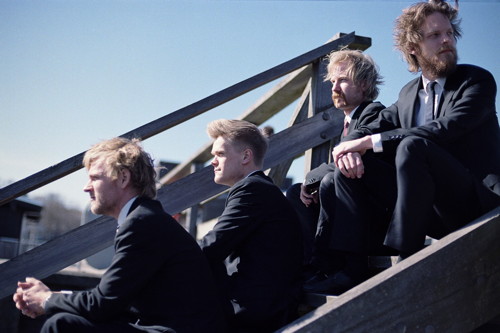Youthful Danish String Quartet needs artistic seasoning

The Danish String Quartet made their Boston debut Wednesday night at Pickman Hall for the Celebrity Series. Photo: Caroline Bittencourt
You’ve got to love a young artist who turns to the audience and openly expresses his awe at being included in a “celebrity series.”
That’s what violinist Rune Tonsgaard Sørensen did Wednesday night as the Danish String Quartet prepared to top off their Boston debut concert—presented at the Longy School’s Pickman Hall by, yes, Celebrity Series of Boston—with an encore, a Danish folk dance.
It was an endearing moment in an evening that could have used a few more of them. The earnest foursome of three Danes and a Norwegian, all a year this or that side of 30—respectively, violinists Sørensen and Frederik Øland, violist Asbjørn Nørgaard, and Fredrik Schøyen Sjölin–seemed more determined to impress with their energy and intensity than to offer the broad range of expression and tone color implied in their program of works by Mendelssohn, Debussy, and Hans Abrahamsen.
The Copenhagen-born Abrahamsen—billed in Zoe Kemmerling’s program notes as a practitioner of a “new simplicity” in reaction to the rigors of mid-twentieth-century serialism—gave the title “Ten Preludes” to his 1973 String Quartet No. 1, and the work does indeed consist of ten short movements.
The Chopin-like title seemed to promise brief, strongly contrasted musical gems, but this work came a little short of that, at least in Wednesday’s concert. The players were equal to the performance challenges posed by Abrahamsen’s fondness for bee-swarm dissonances on the one hand and long unison passages on the other, and they were alert to his textural experiments and hints of folk song, but some opportunities for lush Romanticism or fanciful humor were left on the music stand.
At 18, Felix Mendelssohn was already the composer of the Overture to A Midsummer Night’s Dream and other utterly characteristic works, but the encounter with Beethoven’s recently published last quartets knocked him into another compositional zone altogether. His String Quartet No. 2 in A minor, Op. 13, poses a problem in performance: how to interpret music by one great composer trying to write like another great composer.
One could hope that the Danish players were not so far from their own 18th birthdays that they might hold the key to the riddle. And to a considerable extent, they did. Their determination not to go to Mendelssohn’s “pretty” side may have come from their own performing temperament, but it seemed to match a similar attitude on the part of the composer himself in this work.
After the Adagio introduction in wide Beethovenian chords, the ensemble went for maximum drama in the Allegro vivace, their slashing attacks sacrificing pure intonation for the sake of excitement. In the second movement, they took full account of the young master’s wish to emulate the old master’s vast adagios, enacting the drama’s several acts with a clear sense of pace and scope. The quartet’s sensitive voicing of the many fugal passages here and elsewhere in the work was a pleasure to hear, although its limitations in tone—a little raspy in forte and breathy in piano—were also noticeable here.
The third movement, a pizzicato serenade that sounded more like Bizet than Mendelssohn, was interrupted by a scherzo episode that the players quite properly rendered with a Beethoven-like edge rather than Mendelssohnian fairy dust. The finale, a kitchen-sink Presto with recitative, fugal episodes, dramatic pauses, reminiscences of earlier themes, and an organ-like chorale to close, received appropriately fiery treatment.
In his String Quartet in G minor, Op. 10, Debussy was, like the Mendelssohn of the A minor Quartet, the young composer of a revolutionary stage work (Prélude à l’après-midi d’un faune) wearing borrowed compositional clothes. As if to recognize that fact, and surely with tongue in cheek, the Frenchman followed, for the only time in his career, the Germanic practice of assigning this piece a key and a (meaningless) opus number.
Faced with an interpretive dilemma similar to that of the previous work, the Danish ensemble seemed to handle it the same way, jumping in with both feet and hoping energy, precision, and enthusiasm would carry the day. But the first movement could have used more Germanic clarity in its main theme, and the players’ bold, intonation-bending attacks tended to blur the contrast between passages in major or minor and those in Debussy’s signature whole-tone harmonies. Even the pizzicato scherzo that followed felt somewhat heavy and aggressive.
Relief came in the Andantino, which Debussy marked “sweetly expressive” and then made sure it was so by instructing that the instruments be muted. The Danish players got with the program, producing their most tender and intimate playing of the night. It probably didn’t hurt that they were playing music thought to have been influenced by the lyricism of a Norwegian, Edvard Grieg.
After a suspenseful introduction, the finale flew by, expertly played and leaving not much impression. There was more warmth and interest in the encore, introduced by violinist Sørensen as the quartet’s own arrangement of a centuries-old traditional dance tune associated with weddings.
However, if they want to go beyond celebrity to a long marriage with Boston audiences, these talented Scandinavians will need to bring a richer smörgåsbord next time.
The next presentation of Celebrity Series of Boston is violinst Joshua Bell with pianist Sam Haywood, 3 p.m. Sunday at Symphony Hall. celebrityseries.org; 617-482-6661.
Posted in Performances




